In an editorial printed on Monday morning, Chinese state media outlet Global Times mocked the US and Canadian government’s decision to shoot down an aerial object flying over the Yukon territory over the weekend.
The daily tabloid – which is under the direct control of the Chinese Communist Party – said that both countries were making a “fool of themselves” and putting on a spectacle.
“The US Air Force shot down an “unidentified flying object (UFO)” over Canada on Saturday local time. But officials from both Canada and the US so far have offered neither further clarification on the capabilities, purpose, or origin of the object, nor one on the need or urgency to shoot it down,” wrote the Global Times.
“The F-22, an advanced US military fighter that has undertaken such a “heavy task” to attack the object, has also been dubbed the “Balloon Killer” on the internet. Besides, the US and Canada also made a fool of themselves: The North American Aerospace Defense Command detected another radar anomaly on Saturday night.”
In an attempt to cast shade on the incident, which has since been classified as a national security threat, Chinese state media suggested that it was an oil field drone or a weather balloon.
“This makes people wonder if it was the US military that messed things up,” the editorial claimed.
Global Times alternatively referred to the so-called balloon incidents as “playacting”, “showing off” and “large-scale political behavioral art.” The outlet even went on to claim that people were “high on drugs” for being concerned about the violation of airspace.
Earlier Monday, Prime Minister Justin Trudeau said that in total four objects were brought down over North America this past week and there is some indication that they are related to one another.
“Obviously, there is some sort of pattern in there. The fact we are seeing this in significant degree over the past week is a cause for interest and close attention, which is exactly what we’re doing,” said Trudeau.
Both US and Canadian authorities continue to cooperate and investigate the nature of the objects and whether they have surveillance capabilities.

